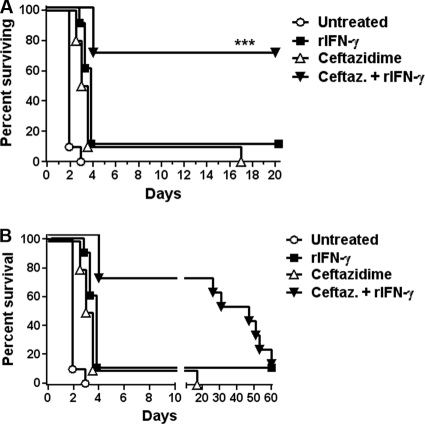FIG. 7.
Treatment with low-dose ceftazidime plus rIFN-γ protects mice from acute but not chronic B. pseudomallei infection. (A) BALB/c mice (n = 10 mice per group) were challenged with 7.5 × 103 CFU of B. pseudomallei administered by the i.n. route. Six hours later the mice were treated i.p. with 25 mg/kg ceftazidime (Ceftaz.) or 3 × 103 U rIFN-γ, or with both in combination. Ceftazidime treatments were continued every 12 h for a total of six treatments over 3 days. Treatment with rIFN-γ was administered twice, at 6 and 18 h postinfection. (B) Mice (n = 10 per group) that initially survived the 20-day short-term period were followed for an additional 40 days to assess the effects of the treatment on chronic infection. At the end of the 60-day observation period, any surviving animals were euthanized and their organs (lung, spleen, liver) were cultured for B. pseudomallei, as described in Materials and Methods. The survival times of the treated and the control mice were determined, and statistical differences in the survival times were determined by the use of Kaplan-Meier curves followed by the log-rank test. The Bonferroni corrected threshold was applied for comparison of multiple survival curves, such that a P value of <0.02 was considered significant for this analysis (***, P < 0.001 for combination therapy versus rIFN-γ treatment and for combination therapy versus ceftazidime treatment). The survival curves represent pooled data from two independent experiments.

